The Secret History Of Ultimate
Ashby Computers & Graphics Ltd, better known under their trading name of Ultimate Play The Game, were the most reclusive and secretive videogame developers of the 8-bit era. Almost never doing interviews and giving very little away when they did, they preferred to let their stream of smash-hit games do most of the talking for them. The anti-Bitmap Brothers, if you will.
The games themselves were just as enigmatic, never really explaining your goal or even how to play. You'd be told the control keys, given a bit of cryptically florid plot waffle and left to get on with it.
But even now, 37 years after the last new Ultimate release, remarkably little is known about how they managed to arrive full-fledged on the scene, already making games that most other releases of the time paled and quailed beside.
And as I'd given myself the week off writing about politics and there wasn't a poker game on, I decided to spend last night having a bit of a dig.
So what do we know for sure? We know that ACG – chiefly comprising the brothers Chris and Tim Stamper – made the arcade game Dingo for Jaleco in January 1983, four months before the release of their first Spectrum title Jetpac. (Dingo is credited onscreen to Ashby Computers And Graphics Ltd, the same as the Speccy classic.)
(And just in case you're not fully up to speed on 21st-century Speccy developments, Dingo was ported brilliantly to the Spectrum by homebrew coders a few years ago, along with an oddly-not-as-good Windows/Mac version.)
It seems to be pretty universally accepted that they also made Blue Print for Jaleco the previous year, though there's very little in the way of actual primary evidence for this – there's no ACG credit anywhere to be seen onscreen and no documentary proof.
However, Tim Stamper confirmed it, in a customarily roundabout style, in a 2015 tweet from a Twitter account that lasted just a few months before lapsing back into silence.
It's certainly in the ACG sort of style, and has a noticeably British sense of humour (get killed early and it'll enquire as to whether you read the instructions). A 1985 article in Commodore User credited Blue Print to the firm, but also Konami's circular shooter Gyruss, which seems to be rather more dubious – Wikipedia lists a whole bunch of Japanese guys as Gyruss's authors, so let's give that one a "Hmmm" for now.
The article says that the Stampers made 12 games for Zilec Electronics, but that the other 10 are "a closely-guarded secret". So what else did Zilec do? Games Database gives us a list which excludes Gyruss but otherwise conveniently comprises exactly 11 games including Blue Print, ie 12 with the addition of Dingo.
We know we're looking at quite a narrow window. The Stampers claimed at the time of their Speccy debut to be "the most experienced arcade video game design team in Britain" so they must have had some titles to their name before May 1983.
Check Man (1982), then, which was released in different versions both by Jaleco and the Stampers' UK employers Zilec Electronics, seems like a no-brainer. It's very much got the look and feel of the games we know they made – simple, tough, addictive pure single-screen arcade action with brash and catchy jingles, bright primary colours and cutesy blocky characters with almost no legs.
It's a great little game and the timing and connections fit. But nobody's ever mentioned it in connection with ACG before, so we don't have anything else to go on.
Wizz Quiz and Cash Quiz, meanwhile, have some interesting features:
Along with some extremely British question categories about Coronation Street, what was at the time still called Emmerdale Farm, and the Beatles, there's a title screen featuring a character that Speccy fans will find quite familiar-looking.
Where have we seen that little fella in the tabard and crescent-moon cap – or a close relative of his – before? Let's teleport him into a different setting:
Wizz Quiz's ticking-clock sound effect is also an absolute dead ringer for Atic Atac's footsteps (the game also features the music from Manic Miner, weirdly). This looks like a bit of an open-and-shut case.
Interestingly, Wizz Quiz – but not Cash Quiz – was also published by Konami as well as Zilec, so maybe we can't rule Gyruss out entirely just yet.
Merlin's Money Maze – a monstrously difficult cash-prizes maze game – also has a familiar-looking wizard and definitely feels like the work of the same authors as Cash Quiz and Wizz Quiz, so we'll provisionally chalk that one up too.
(Incidentally, MMM wouldn't have been the Stampers' only dabble in what the arcade industry calls Skill With Prizes (SWP) gaming. In 1991, as Rare, they collaborated with Capcom of all people on a Spot The Ball ticket-redemption game, which despite being built around 1980s UK "soccer" was made for the US market.)
From here, though, the clues start to get thinner on the ground. Not listed on that GDB page is another Zilec/Jaleco collaboration with the rather clunky name of Grasspin, but the video of it on YouTube that resulted from a search of Jaleco games of the time for possibilities immediately screamed "ACG".
The unnamed protagonist could easily be JJ from Blue Print's big brother or cousin, but while the game displays no official credits the high-score table is populated with a bunch of Japanese names.
(Fun trivia fact: Grasspin's music is a slightly tweaked version of the soundtrack from Namco's New Rally-X, released two years earlier, and itself based on the intermission music from Pac-Man.)
However, trying to research Grasspin – a game that appears to be almost totally undocumented by history, with not a single cabinet shot, flyer or marquee apparently in existence – led to the Wikipedia entry for Jaleco, which despite the Japanese names sure enough credits it to ACG, although it doesn't offer any citation for the claim.
It also adds Saturn (1983) from the GDB list. Saturn is a pretty bog-standard Galaga derivative (except when it turns into Time Pilot for Level 3), and the only semi-tangible connection is that it has a very similar front end to Blue Print. Interestingly, it does share some aspects of Gyruss, though, in the way you travel through a solar system past various planets to the accompaniment of vaguely classical-sounding music.
We have no reason to disbelieve the Wiki entry at this point, so let's pencil it in as well.
What about the rest of the GDB list? We can rule out Reaktor as it's from 1987, which is far too late. And we know from a Retro Gamer feature sometime in 2011 (issue 85) that The Pit was the work of a Bridlington chap by the name of Andy Walker, later of Taskset. But funnily enough there IS a strong Ultimate connection there, as revealed by a post on an arcade-history website:
The same article the above quote is taken from notes that Walker went on to design an unproduced game called Stamper. The RG feature, meanwhile, also posits the notion that The Pit, which came out in 1982, may in fact have been the Stampers' very first published videogaming work, so it must have preceded Blue Print the same year.
(This seems an apt time to repeat my own recent call – made with no idea of the Ultimate connection – for a Speccy port of The Pit to be written. Guys, it's a top game, it was the father of Dig Dug and Boulder Dash (and Gran Turismo) and it might be the first Ultimate game FFS. I've already done all the graphics, let's get it where it belongs and not leave the job of representing The Pit on 8-bit computers to the – ugh – C64.)
But WAS it the first? Vortex dates back to 1980 and is a primitive monochrome Asteroids variant produced for Zilec by Associated Leisure that's most notable for only giving the player two lives, but it's possible the Stampers did some sort of work on it, as we learn from another Retro Gamer piece a year earlier (issue 73):
Phantoms II, another mono affair from 1981 which ran on Space Invaders hardware and was a hack of a colour version called Enigma 2, might also just sneak in before they left that year to form ACG and work on Blue Print and Dingo. It's notable only for the fact that if you hold down the fire button your spaceship launches into the air, almost as if it was attached to some sort of… jet pack.
(The attract sequence also sees a couple of large credits-bearing fighter jets scroll onto the title screen in a manner rather reminiscent of that in Saturn.)
So most of this is a little vague, very much in keeping with the usual Ultimate modus operandi. But when I posted these musings on a couple of Speccy forums in what by this point were the wee small hours, information started to leak in from alert readers.
People more skilled than this reporter had analysed the games' code, revealing that Blue Print, Grasspin, Phantoms II/Enigma 2 and Saturn – and, it later transpired, Vortex – are definitely the work of the ACG team. There's nothing conclusive for the quiz and maze games, and slightly surprisingly Check Man is credited to a different set of people entirely – Duncan Shortland, Peter Hughes and Malcolm Mailer, who also gets a credit in Cash Quiz.
Less surprisingly, there's nothing in Gyruss suggesting it's the work of anyone but the Japanese team listed on Wikipedia. BUT we can't rule out the idea that ACG sold a paper design or a prototype to Konami, who then coded/recoded it from scratch on new hardware as their own game.
There's no evidence to believe that actually happened, but it's just such an odd story for Commodore User to have completely invented, especially as they make so little of it in the article. A reader also pointed to a Home Computing Weekly scan from August 1993, showing a storyboard in the Ultimate office with a distinctly Gyruss-ish circular space shooter on it resembling nothing else they're ever known to have created.
So where are we up to? We now have some sort of confirmation for the following:
DEFINITELY BY ACG (THE STAMPERS/JOHN LATHBURY)
Vortex
Enigma 2
Phantoms II
The Pit (conversion of)
Blue Print
Saturn
Dingo
And then there's these:
POSSIBLES/PROBABLES
Wizz Quiz
Cash Quiz
Merlin's Money Maze
UNLIKELY
Check Man
Gyruss
(Because there were two quite different-looking versions of Check Man published by two different companies, we can't 100% rule out that it actually was an ACG game sold to someone else who put credits in their version, but since the credits appear in the Zilec version, which is presumably the original, that seems a long shot.)
So that's 10 (if we include The Pit) of the supposed 12 ACG arcade games identified by CU. Were they counting Check Man and Gyruss – wrongly – as the other two? And what was the mysterious ACG-penned Sega game they mentioned? We may never truly know. But at least it gives us the chance to look at a few obscure old games with fresh and perhaps more appreciative eyes, eh?
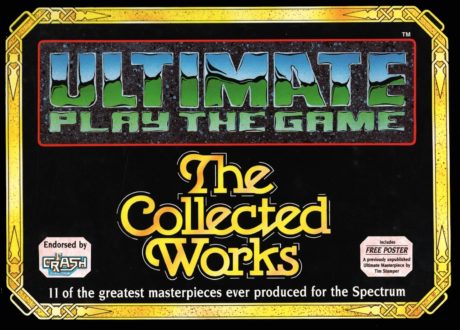
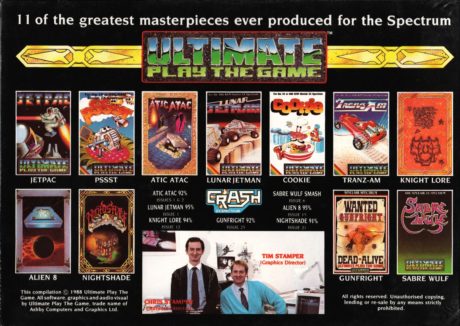
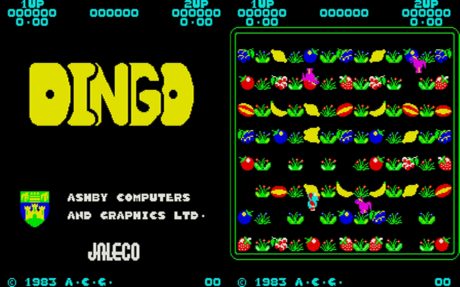
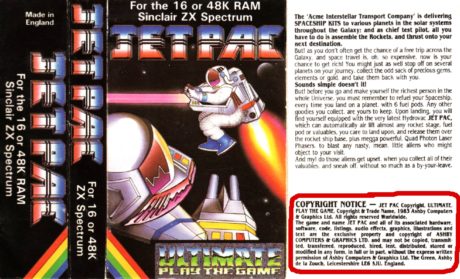
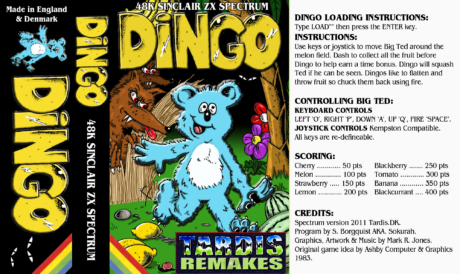
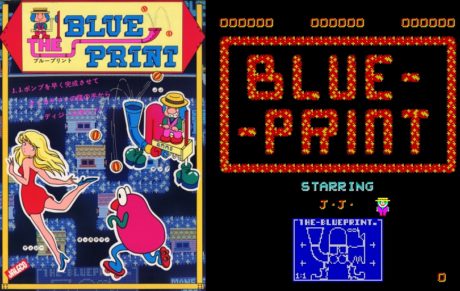
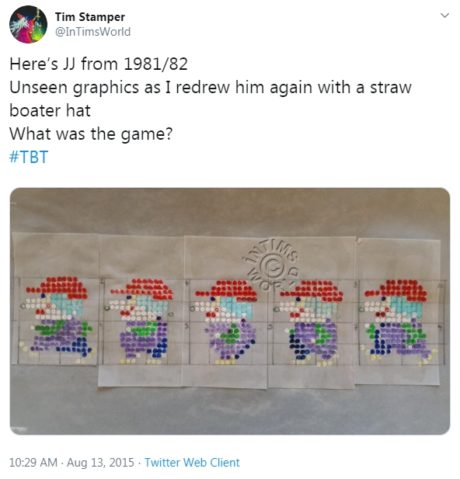
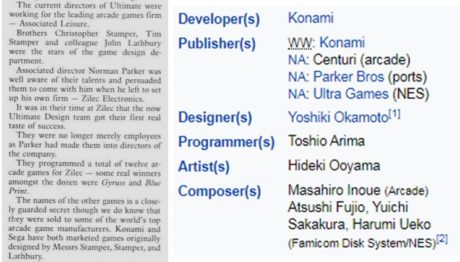
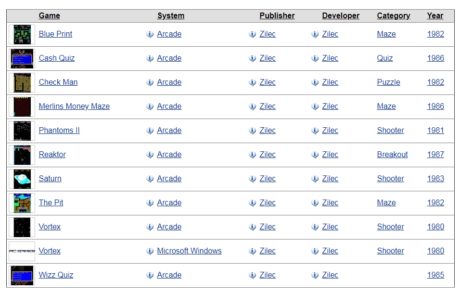
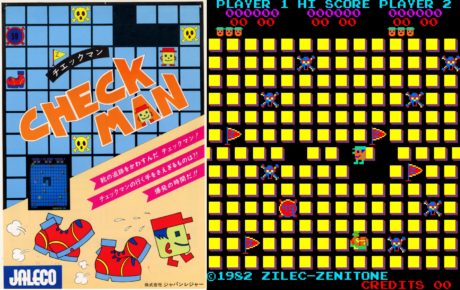
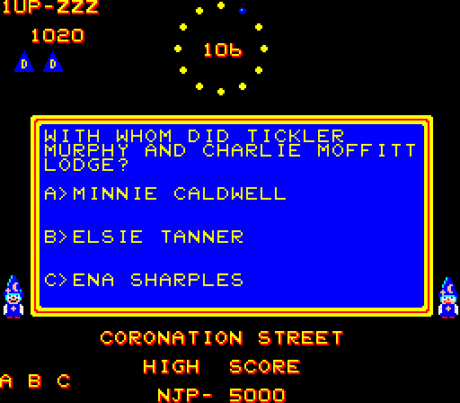
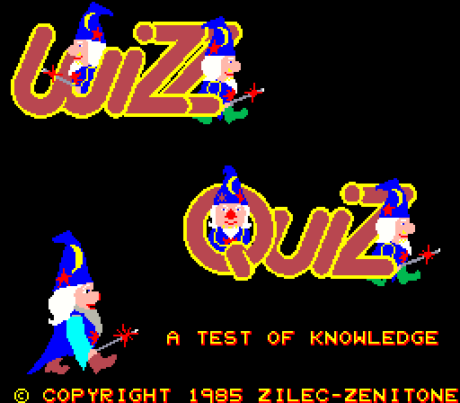
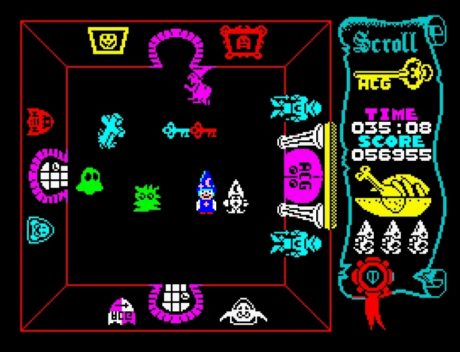
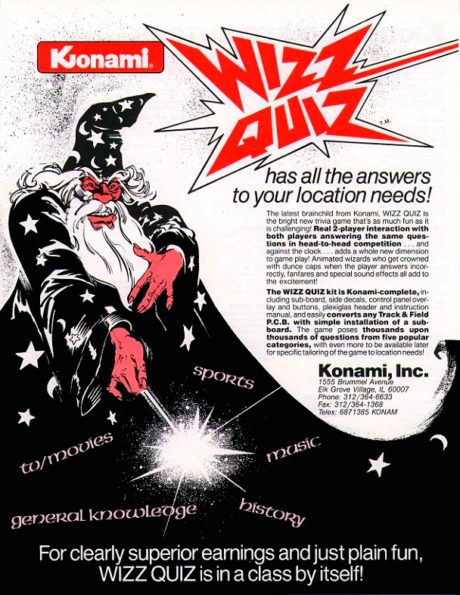
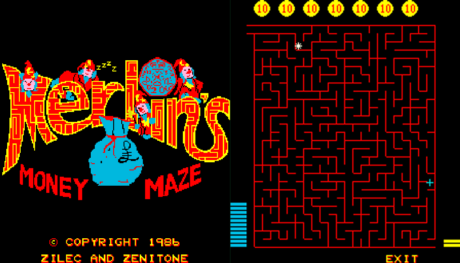
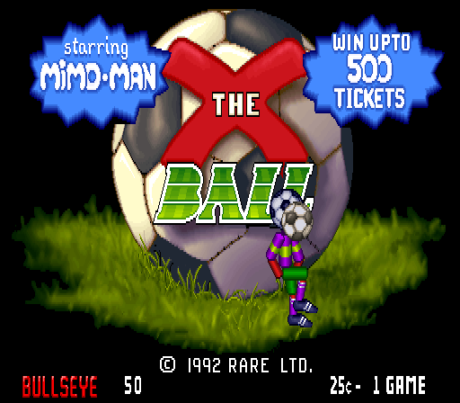
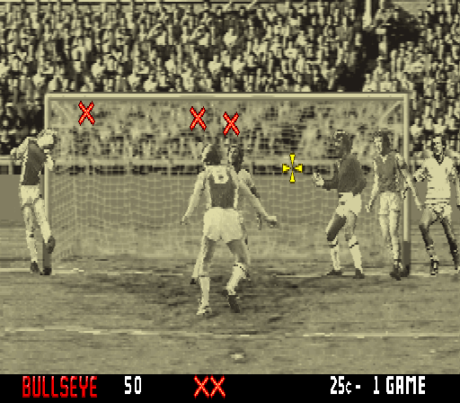
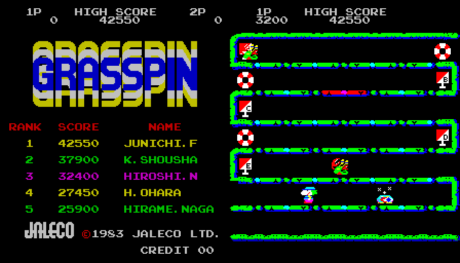
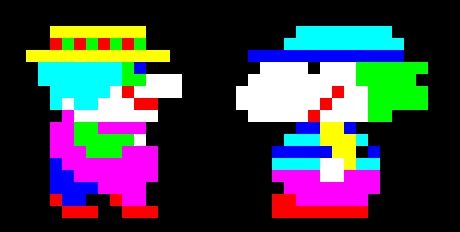
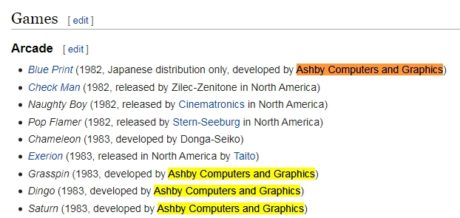
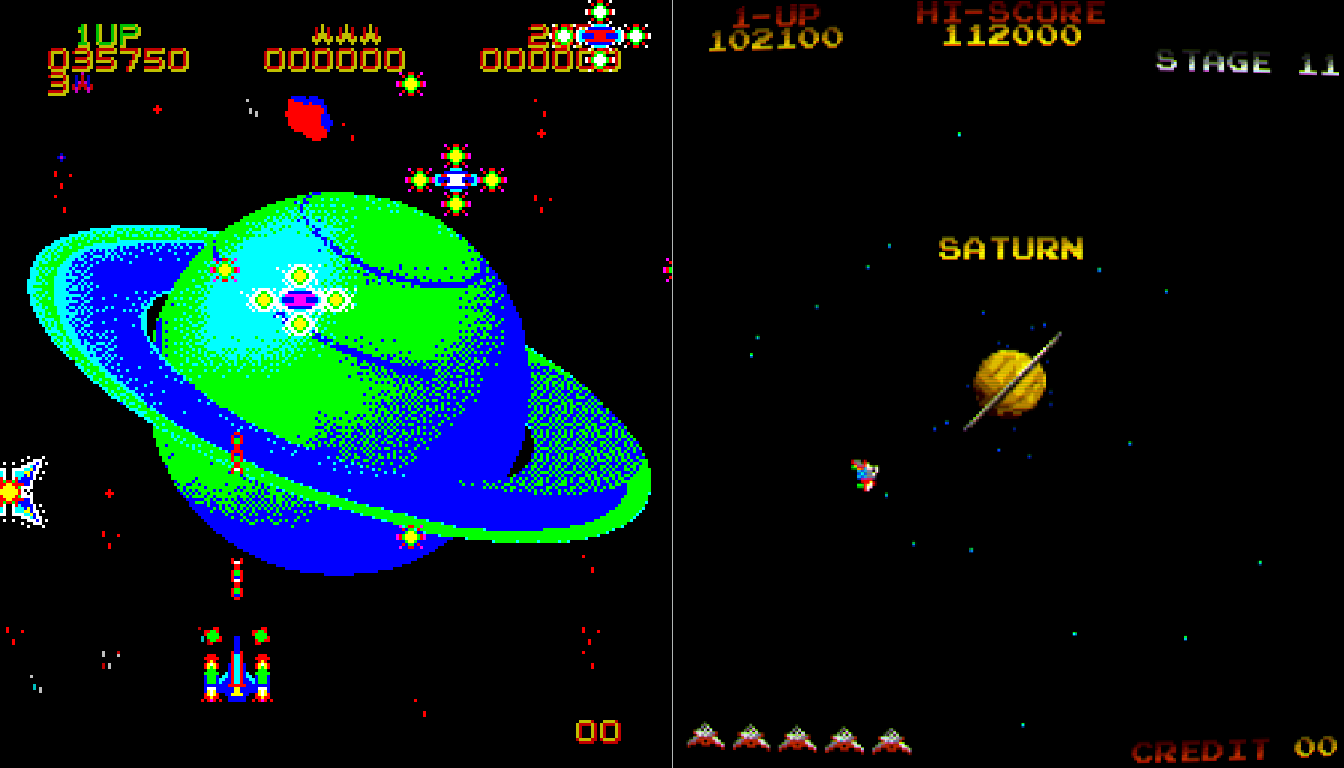

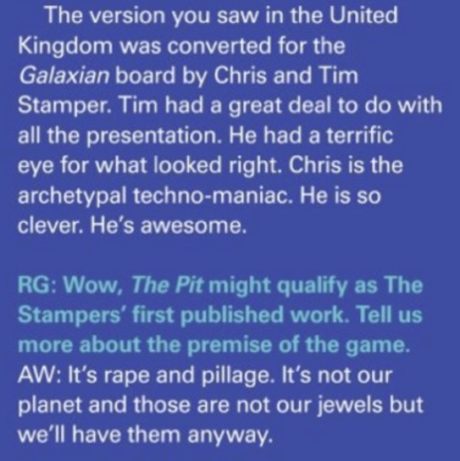
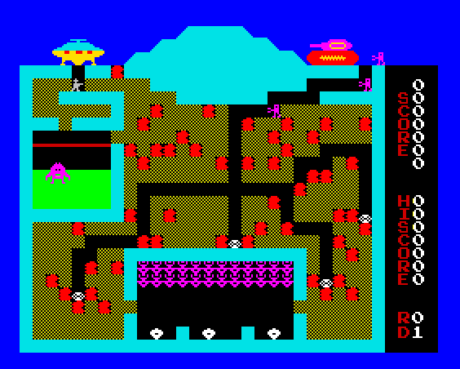
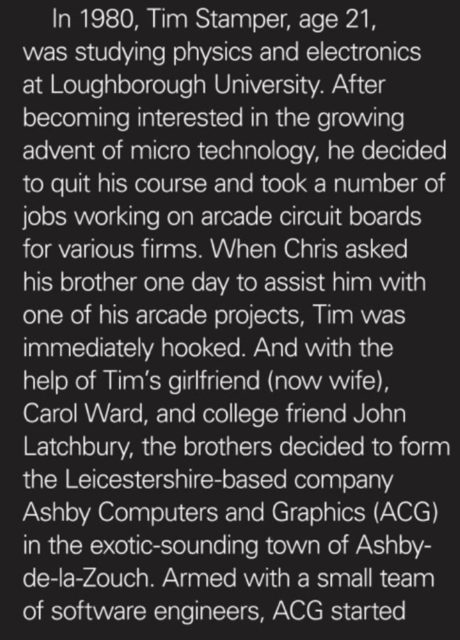
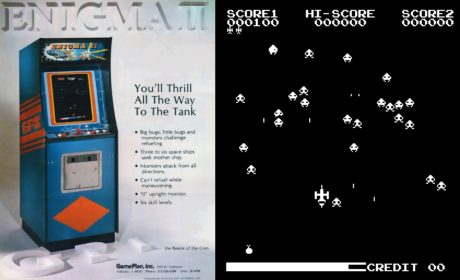
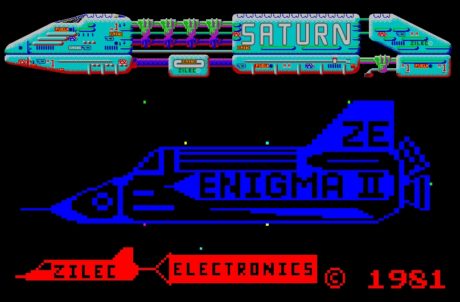
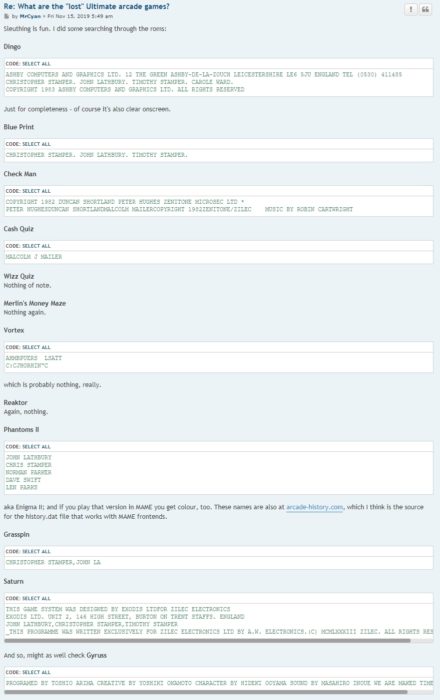
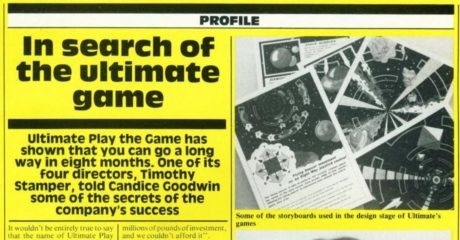
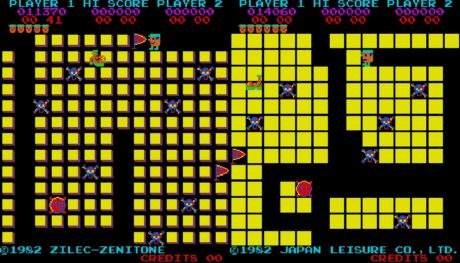


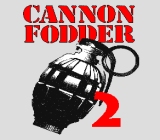

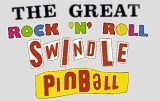

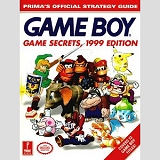

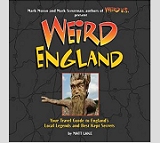
Ahhh, Gyruss—I have two PCBs of that, it's one of my favourite games ever. Love that Wizz Quiz flyer, I don't think there's any piece of art that wouldn't be improved by the addition of a wizard throwing gang signs while magicking the word SPORTS from the howling aether.
Hope the week off has been relaxing, Stu!
Very interesting. Love a good retro fix after work. If I mind right , Ultimate where one of the first companies to whack the cost of their games up from a fiver to a tenner , bloody cried when that happened. Keep up the good work.
Nice article and detective work Stu.
I remain an absolute fan of Ultimate – back in the Speccy days these games not only were absolutely way beyond most of what was being released, they also made my C64 friends pretty envious, for once.
Which, as a petty youngster at school, was nice to lord it for a change. :)
Fascinating. I’ve long had a bit of an obsession with Check Man, as it’s the first game I ever remember playing. I’ve never seen the second version though.
I’m sure I also remember a version where you could slide the tiles left and right to you were never nixed off, but buggered if I can find anything about it.